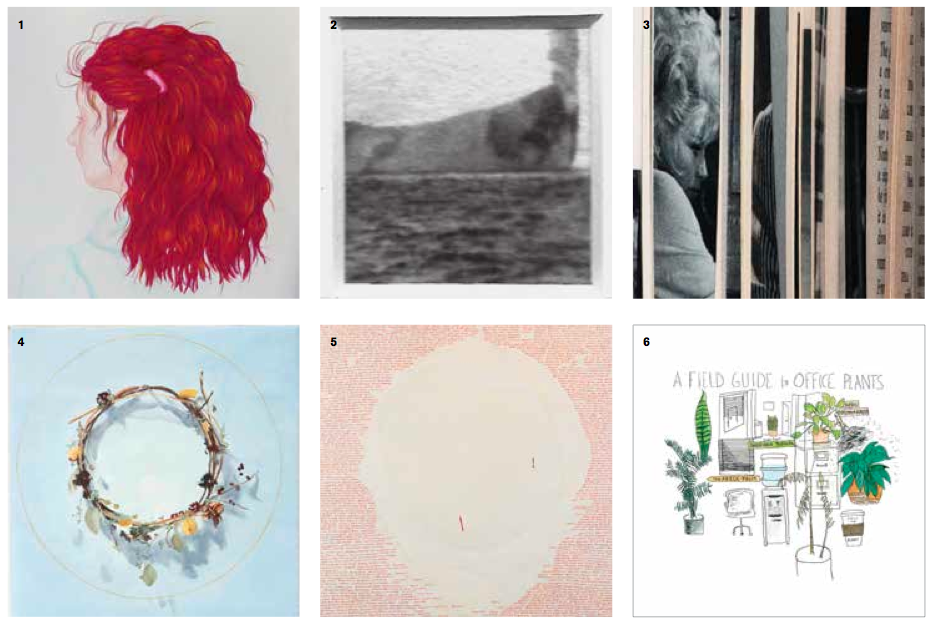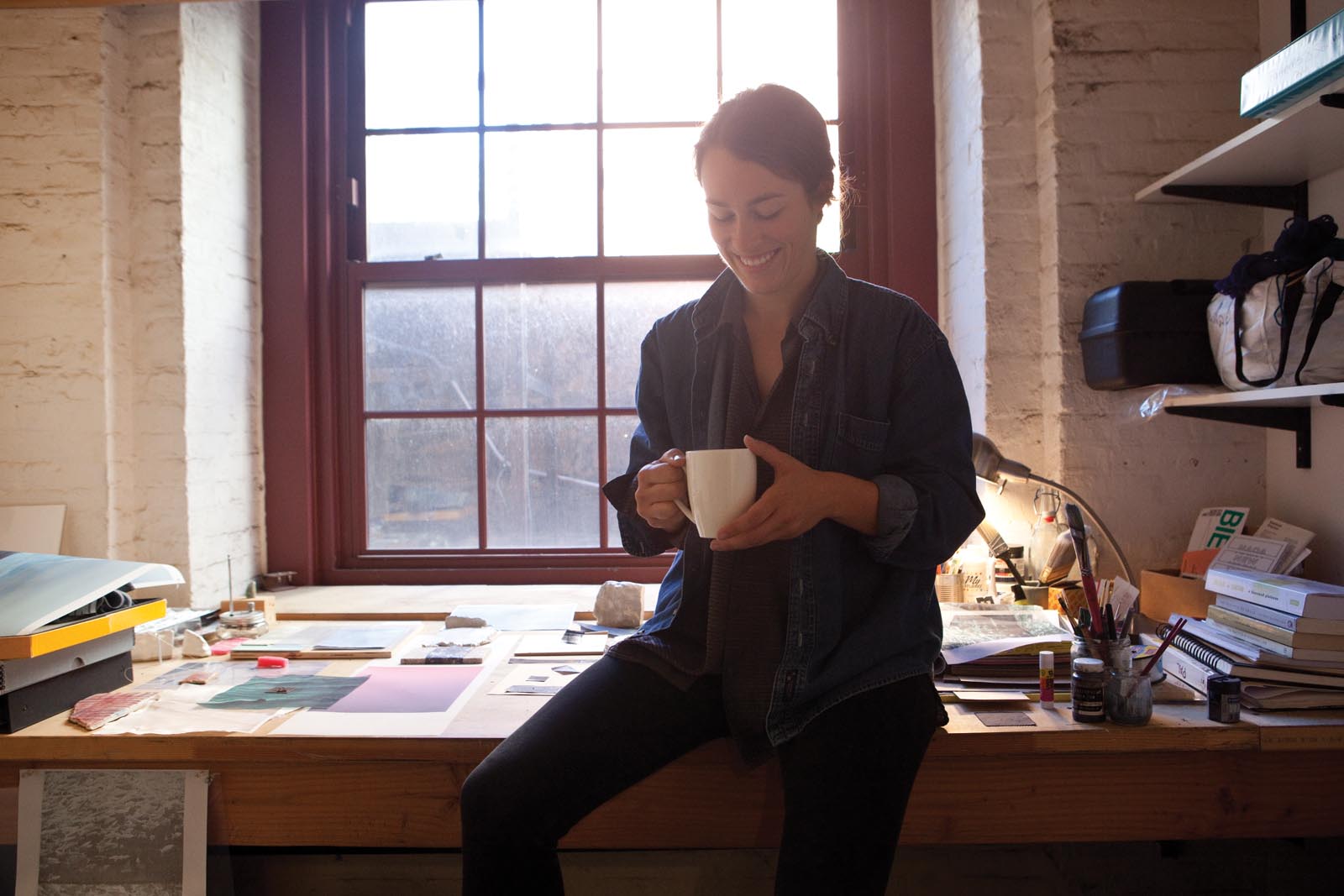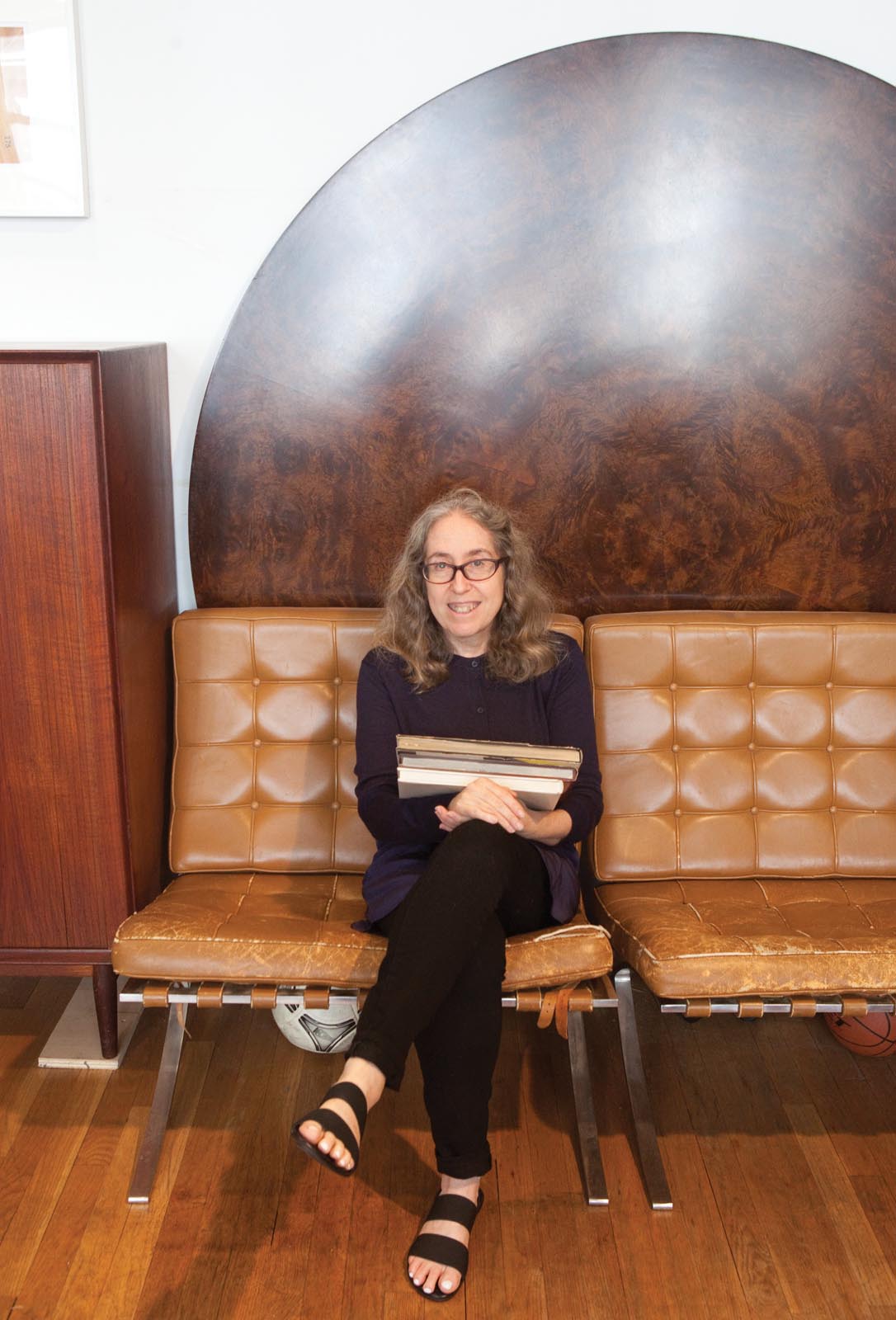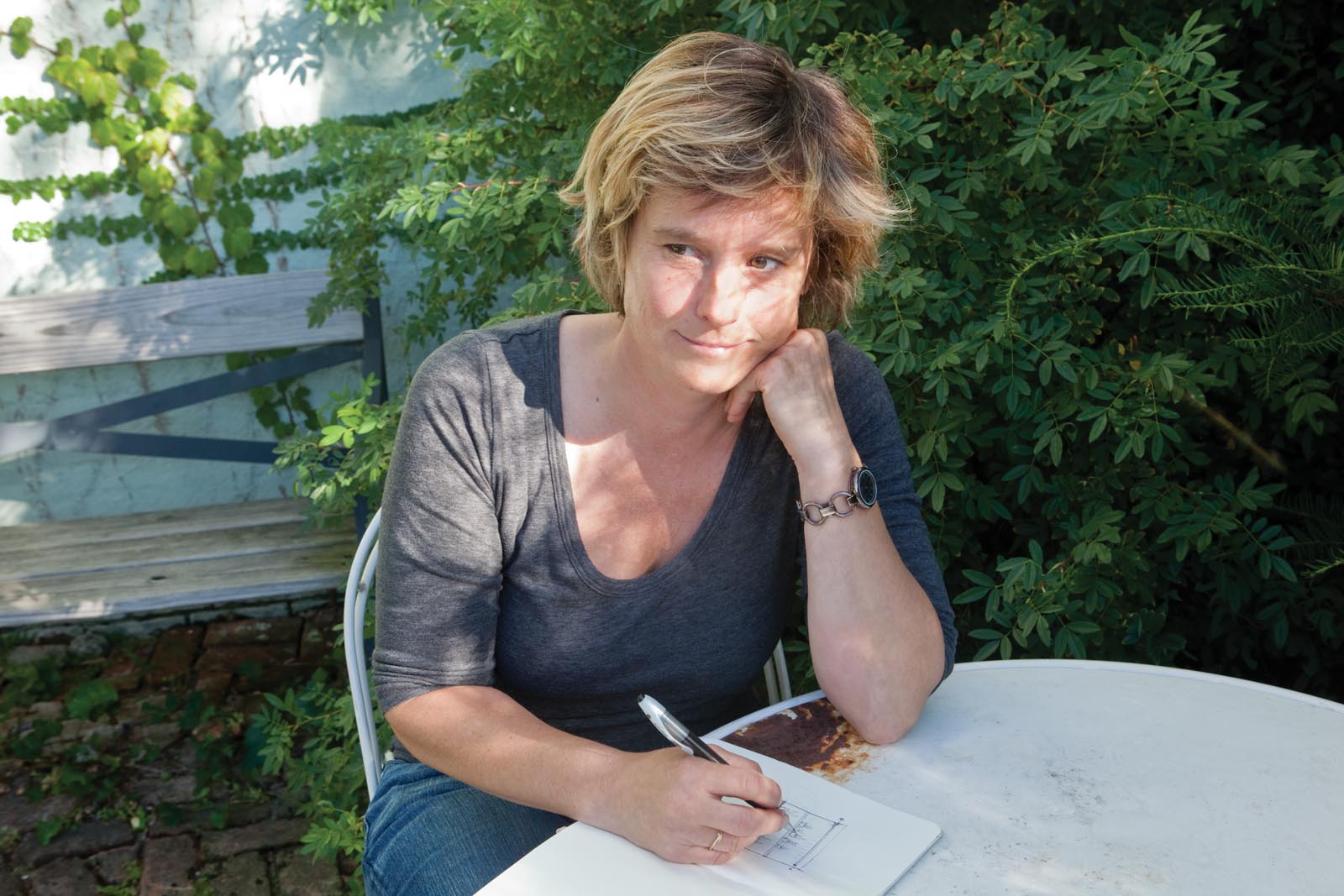Lucid Gestures: An Exhibition of Barnard Alumnae Artists honors the 125th anniversary of the College with a diverse range of works, from a text-filled painting to a computer-generated video. The show, which runs from October 24 through November 17 in the Louise Heublein McCagg ’59 Gallery, is the brainchild of Eunice Kim (right in photo above) and Vanessa Thill, both from the Class of ’13. Last spring, the recent graduates proposed an exhibit, catalogue, and series of video interviews featuring alumnae artists, writers, and curators as a project for Barnard’s milestone anniversary. Thill and Kim, like many of the artists appearing in the show, benefited from significant artistic training at Barnard; both majored in art history with a concentration in visual arts. Both are working artists;Thill specializes in mixed-media sculpture, and Kim in photography and printmaking.
The show’s aim is, among other things, to draw attention to the methods of each artist; “an analysis of specific approaches,” the curators’ proposal explains, “can reveal theoretical substructures that reflect larger cultural forces.” The exhibit’s themes include the examination of preexisting social structures and an interest in the production of work. “Our goal is recognition,” they write. “Of contingencies and contexts, of diverse subjectivities, and of women’s real accomplishments.”
The featured artists include such names as Mierle Laderman Ukeles ’61, Erica Baum ’84, Margaret Lee ’01, Marina Zurkow, and the late Sarah Charlesworth ’69, and represent a broad array of styles, techniques, and concerns. The curators selected them after an application process and a series of studio and gallery visits. Zurkow’s Mesocosm (Wink,Texas) uses video animation to present a surreal and futuristic scene: a pool ripples; clouds pass; smokestacks flare; wolves wander by; a man in a yellow hazmat suit comes and goes. The landscape subtly evolves for 146 hours without repeating. Ukeles’s photograph Washing,Tracks, Maintenance: Outside captures another kind of process: the artist’s self-imposed task of cleaning the Wadsworth Atheneum in Hartford, Conn., one of many pieces of “maintenance art” she has produced.
Other pieces ask viewers to question the limits of representation. In Margaret Lee’s The World Is Not Your Oyster (Lemons and Lime Table), fake citrus fruits support one leg of a table, and the tabletop bears the image of another table. Reality seems just as tenuous in Baum’s Irma, an image that captures the turning pages of a book; each page constitutes a smaller image within the larger one.
We invite you to learn more about the lives and art, and what inspires it, of several of the artists whose work is featured in Lucid Gestures: An Exhibition of Barnard Alumnae Artists. During our anniversary year of Barnard Magazine issues, we expect to feature other works by artists in this exhibition.
—by Abigail Deutsch

Above 1 Lizzy De Vita, Untitled (Redheads), 2009–present, colored pencil on paper, ongoing performance, Courtesy of the artist 2 Ada Potter, Ice Field #2, 2014, platinum palladium print fragment, 1 x 1 in, Courtesy of the artist 3 Erica Baum, Irma from Naked Eye, Volume Two, 2011, archival pigment print, 16 x 11.6 in, Courtesy of Bureau 4 Emily Weiner, You and I Are Disappearing, 2012, oil on linen, 20 x 16 in, Courtesy of the artist 5 Annabel Daou, for sale, 2012, ink, gesso, repair tape on paper, 54 x 40 in, Courtesy of the artist 6 Christina Kelly, A Field Guide to Office Plants, 2014, artist book and installation Courtesy of the artist
 Lizzy DeVita '08 • “I feel to a certain degree I discovered art at Barnard,” says Lizzy DeVita, who studied drawing and printmaking as an undergraduate. Her artistic education extended beyond the classroom: she was a regular at the Metropolitan Museum of Art and at several Chelsea and Brooklyn galleries. After graduation, she relied on other Barnard alumnae for feedback and exhibited alongside them in shows; these young artists and curators constituted “an informed community around me,” she says.
Lizzy DeVita '08 • “I feel to a certain degree I discovered art at Barnard,” says Lizzy DeVita, who studied drawing and printmaking as an undergraduate. Her artistic education extended beyond the classroom: she was a regular at the Metropolitan Museum of Art and at several Chelsea and Brooklyn galleries. After graduation, she relied on other Barnard alumnae for feedback and exhibited alongside them in shows; these young artists and curators constituted “an informed community around me,” she says.
Barnard’s influence has followed DeVita toYale, where she is in her second year of a master’s of fine arts program. A Barnard fellowship helps fund her MFA, and last summer she traveled to Poland with Joan Snitzer, director of the Barnard visual arts program, and with alumnae and current students.There, a performance and workshop helped shape her thinking “about improvisational group work.” Her piece in the McCagg Gallery exhibition, Redheads, consists of a series of colored-pencil drawings of red-haired women, all turned away from the viewer at the same angle. Do the illustrations all depict the same woman captured at different points in time, which would explain the varying lengths and styles of hair? Or do they show different women who happen to look quite similar, all captured at the same moment? They’re not telling us—and the orientation of their heads reinforces their mysteriousness.
DeVita’s current projects echo this emphasis on the human form. She is creating “a series of sculptural instruments, customized to fit specific body parts of people who will use/wear them.” One connects two people’s teeth and another fits the ribs of two wearers and the neck of a third; each inhalation a participant takes affects the breathing of the others. Both instruments, DeVita explains, force multiple people to behave as a single unit.
—AD

Although Ada Potter entered Barnard as an anthropology student, she eventually switched to art history and studio art, where she “felt like I could talk about the topics we were covering in anthropology in a more interesting way visually.”
Attracted to Barnard because it is in NewYork City, she took advantage of art- world internships. Since graduation she has worked at the Parrish Art Museum on Long Island, Pace Gallery in Manhattan, MoMa PS1 and the New Museum.
As someone who “never thought of myself as an artist,” Potter says Barnard helped her find “the confidence to claim that title.” Since exhibiting her work at the McCagg Gallery as an undergraduate, Potter has shown her digital prints, installations, and photography at the ARC Gallery at Pratt Institute, the Apartment Show, and Greenpoint Gallery.
“Recently, my work has been a lot about the way art circulates, the way it becomes material and ephemeral,” she says, adding that she also explores “what it means to be digital” with print images.
Potter credits Joan Snitzer in the art history department for her help on many levels. “She kept us all together, is supportive, intelligent, and she elevates
the conversation. She gave us license to be intellectual and conceptual artists.” Snitzer also helped Potter “connect with my first gallery position in NewYork.”There were also other department mentors, including John Miller, Julia Westerbeke, and Alexander Alberro. Potter is now an MFA candidate in sculpture at Pratt Institute, and had a summer residency in sculpture at the School of Visual Arts.
She also curates exhibitions, including one recently on the Lower East Side. “I define myself as interdisciplinary,” says Potter. “Barnard helped me do
that. Having art history as a necessary education for what’s come before you is really crucial.” Potter adds, “I feel so lucky, my family is involved in the arts. I grew up in it. The quantity and quality of [art] production here in New York is pretty inspiring.”
—by Merri Rosenberg

Erica Baum '84 • The distinctive vision of Erica Baum features black-and-white photographs incorporating printed materials to form “found collages.” Her work is in the collections of the Metropolitan Museum of Art,Whitney Museum of American Art, and Solomon R. Guggenheim Museum, among others. More than 100 of her works were featured at the São Paulo Bienal 2012; she has also been part of Art Basel in Miami Beach. The New Yorker, Art in America, and Artforum regularly feature Baum’s work. Last year, she had solo shows in Athens, Berlin, and Paris; in 2015, she will show at the KunstHalle in Berlin and the Guggenheim.
Baum majored in anthropology at Barnard, because she felt “it could inform my art.” She also credits the linguistics, poetry, and literature courses as significant influences on her work, which she describes as focusing on “found text, concrete poetry, and conceptual poetry.” As Artforum wrote about her exhibition this fall at Bureau, her home gallery on the Lower East Side, “text (and the literary pleasures associated with it) remains instrumental to her recent pictures.”
Baum grew up in Morningside Heights. She recalls that “I wasn’t assigned a dorm because I lived too close” to campus. She took art history courses, but pursued the practice of art on her own. “Studio courses were not easy to get into.”
After Barnard, Baum earned a degree from Hunter College in TESOL/applied linguistics and developed a portfolio that enabled her to apply to Yale for an MFA in photography. “While I taught TESOL to lots of immigrant populations, I also worked in nonprofits and public art where I did photography of the projects, which was a blend of art and anthropology,” says Baum. Barnard continues to have an impact on Baum: “The thing that’s been wonderful about staying in NewYork is that there are a lot of Barnard alums.” Recently, she collaborated with poet Idra Novey ’00. “It was a happy surprise that she had gone to Barnard. There was a feeling of recognition.”
—MR

Emily Weiner '03 • At Barnard, Emily Weiner took as many painting courses as she could, and spent much of her time “holed up,” as she describes it, in the Dodge painting studio at Columbia alongside similarly passionate peers. Art proved crucial at a difficult moment: “One of the biggest impressions made on me was an advanced painting class I took the semester of September 11, instructed by Archie Rand,” she says. “It was a weird time for obvious reasons, and there were a handful of us who didn’t really know what to do except go on painting in the studio, which I think really validated the necessity for making art for me.”
Majoring in art history with a concentration in the visual arts, Weiner credits a trip to London, organized by Professor Joan Snitzer, for solidifying connections among students, “several of whom became my closest friends and artist colleagues, and remain so today.”
After graduating from Barnard, Weiner received her MFA in fine arts from the School of Visual Arts in 2011. She teaches at Pratt and School of Visual Arts (SVA), and is offering a painting course to Barnard alumnae this fall. In addition, she coruns Soloway, a Brooklyn gallery, and The Willows, an occasional exhibition series hosted in a Brooklyn Heights apartment.
Weiner has contributed a haunting oil-on-canvas diptych to Lucid Gestures. You and I Are Disappearing is a study in circles: in one image, a ring of flower stems, leaves, and petals soars above the stone wreath on a tombstone; in the other, a halo surrounds a floral wreath. “ICI REPOSENT,” reads the lettering on the grave: “Here rests.”There the words end; we never learn who lies there, who has disappeared. Even the final letters of “REPOSENT” grow less legible, as though the word itself is vanishing into the stone.
—AD
 Annabel Daou '89 • Annabel Daou left her native Beirut to attend Barnard and quickly embraced NewYork City. Now living in Brooklyn, Daou explores the intersection of text and image; her haunting works on paper include fragments, torn sheets, quotations, and numbers that yield what Daou calls “repaired landscapes.” Her work has been shown at the Park Avenue Armory, the Phillips Collection in Washington, D.C., and at MoMA PS1, as well as in exhibitions and galleries around the world. She represented the United States at the 12th International Cairo Biennale in 2010, where she also received an award. She is a cofounder of dBfoundation, and a cofounder of S2A, arts platforms based inNewYork.
Annabel Daou '89 • Annabel Daou left her native Beirut to attend Barnard and quickly embraced NewYork City. Now living in Brooklyn, Daou explores the intersection of text and image; her haunting works on paper include fragments, torn sheets, quotations, and numbers that yield what Daou calls “repaired landscapes.” Her work has been shown at the Park Avenue Armory, the Phillips Collection in Washington, D.C., and at MoMA PS1, as well as in exhibitions and galleries around the world. She represented the United States at the 12th International Cairo Biennale in 2010, where she also received an award. She is a cofounder of dBfoundation, and a cofounder of S2A, arts platforms based inNewYork.
Daou majored in the visual arts with a focus on art history. She credits Joan Snitzer with helping her obtain work in a studio. As a Barnard student, Daou also ran drawing classes for an instructor at Columbia.
She moved to London after her graduation from Barnard, and spent time in Europe as an editor and researcher for exhibitions. After 2003, Daou, who speaks English, French, and Arabic, felt the need to switch her medium. “When we went into Iraq, I wrote the United States constitution in Arabic, phonetically,” she says. “It was not a political gesture. It was about how language makes you see, and the misunderstandings that result. Part of it was the idea that people were terrified of words in Arabic. There was fear at the look of the language.”
She adds, “My work is about how you look at language. When you see language in art, you hear the sound in an interesting way.You see it as an image.” No surprise then, that she says the poetry class with Professor Barry Ulanov, affected her most at Barnard.
Daou is grateful that Barnard offered grants and work-study jobs, including one at Columbia’s admissions office. She credits Snitzer for her ongoing support. “She’s a person who wants to help and connect everybody.”
—MR
 Christina Kelly '93 • Rachel Carson’s The Edge of the Sea, Michelangelo Antonioni’s L’avventura, Sappho’s poetry, old Brooklyn Eagle articles, the growth of corn: such are the diverse inspirations of Christina Kelly ’93. She pursued her various passions at Barnard, majoring in English and helping run the Barnard film society, Zooprax. The society introduced her to French New Wave films that influenced her work as she pursued a master’s of fine arts in film and video, which she received from Bard College in 2000.
Christina Kelly '93 • Rachel Carson’s The Edge of the Sea, Michelangelo Antonioni’s L’avventura, Sappho’s poetry, old Brooklyn Eagle articles, the growth of corn: such are the diverse inspirations of Christina Kelly ’93. She pursued her various passions at Barnard, majoring in English and helping run the Barnard film society, Zooprax. The society introduced her to French New Wave films that influenced her work as she pursued a master’s of fine arts in film and video, which she received from Bard College in 2000.
For a number of years, Kelly worked as a film and television editor, and her own artwork primarily took the form of film and video. The birth of her son, and the advent of the global financial crisis, inspired her to produce research-based projects that evolved over long stretches of time.
Kelly’s switch in focus—and her enthusiasms for narrative and nature— marks her contribution to Lucid Gestures. A Field Guide to Office Plants is an installation that mimics an office cubicle, complete with table and plants. The table bears copies of an art book—the “field guide” itself. With this project, Kelly hopes to convey the idea “that even an everyday, mundane and overlooked thing (like an office plant) might have a surprising back story,” she says. “It’s also a testament to curiosity, and the value of pursuing something that seems to have no measurable or accountable worth.”
The artist is now at work on two projects. One is a comic “inspired by the life, loves, and imagined psychoanalysis sessions” of Goodnight Moon author Margaret Wise Brown. Another involves a range of media that reflects Kelly’s diverse interests: animated films play on old smart phones that sit inside outdated cameras.
—AD
